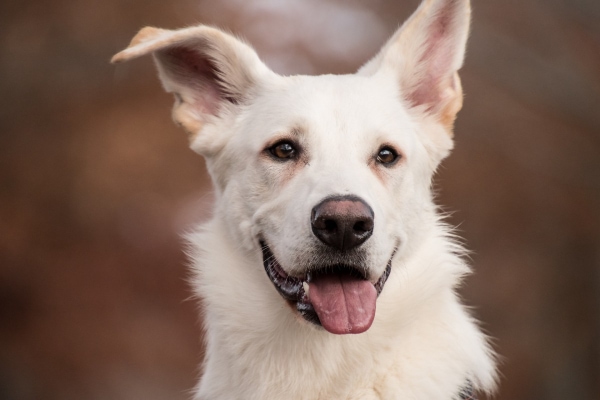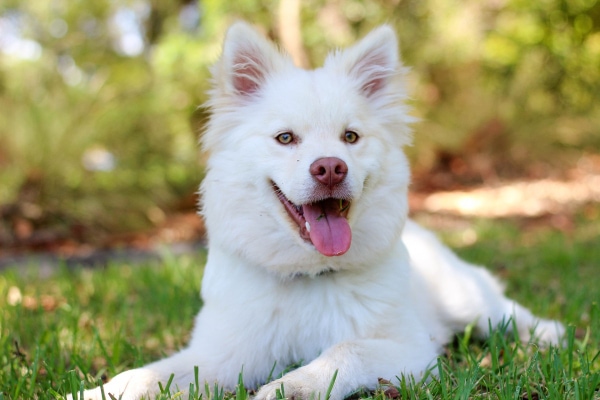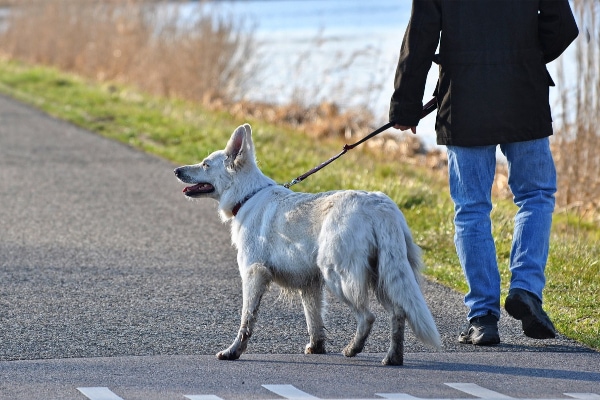Communicating with a deaf dog presents unique challenges, but these special pups are certainly able to understand us. Integrative veterinarian Dr. Julie Buzby outlines some ways to effectively communicate with your deaf dog.

Can my deaf dog understand me?
A dog experiences the world differently from you and me. Dogs utilize all manners of non-verbal communication. Even hearing dogs rely heavily on body language. Think about your interactions with dogs, or witnessing dogs interacting with each other. Here are just a few examples:
- Posture – Is the dog upright and confident, or crouched and cowering?
- Ear position – Are the dog’s ears pinned back, relaxed, erect?
- Tail position – Is the dog’s tail tucked, held upright, or wagging?
Deaf dogs may not be able to hear our words or tone, or other dogs’ barks, growls, and whimpers, but they certainly understand body language just like any other dog!
What causes hearing loss in dogs?
The Deaf Dog Education Action Fund (DDEAF) reports that hearing loss in dogs occurs for many of the same reasons people go deaf. Genetic defects can cause a puppy to be born deaf, and adult dogs can lose their hearing due to chronic ear infections (i.e. otitis in dogs), an injury to the ear, exposure to loud noises, and as an uncommon side effect from ear medications.
Seniors dogs are also prone to gradual deafness due to old age. Sometimes older dogs can hear higher-pitched noises like whistles or clicks more easily than human voices.

Some breeds are more prone to congenital deafness. Typically, breeds that have white pigmentation, such as Dalmatians and Australian Shepherds, are at an increased risk of congenital deafness, although it can occur in any breed. Pigment cells in the inner ear are vital for normal hearing, so dogs with white pigment on the head and face may also lack these pigment cells in their ears.
How do I know if my dog is deaf?
The most accurate way to tell if your dog is deaf is with the BAER (Brainstem Auditory Evoked Response) test. The procedure uses computers to record the electrical activity of the brain in response to specific sounds and pitches.
BAER testing is typically performed by a veterinary neurologist and may not be offered by your regular veterinarian. As an alternative if this test is unavailable to you, DDEAF also recommends this do-it-yourself test to determine hearing loss:
- Jangle keys or a can of coins.
- Squeak a toy while it is behind your back.
- Call your dog’s name in a normal voice. Then try yelling the name.
- Clap your hands. (You should be far enough away so that he doesn’t feel air movement.)
- Turn on a vacuum cleaner. (Be sure it’s far enough away from the dog so that the vibrations or airflow don’t reach him.)
- Ring the doorbell.
Dogs who do not react to these auditory stimuli may have some degree of hearing loss. If you’re concerned that your dog may have hearing loss, consult with your veterinarian.
If your dog is diagnosed with deafness or hearing loss, you will probably be more upset about it than your dog will be. Dogs are resilient and don’t feel sorry for themselves.
How can I communicate with my deaf dog?
Dogs do not communicate the way humans do. Dogs tell each other about themselves through visual body cues and scent before adding verbal signs like barking, growling, or whining. That’s why communicating with your deaf dog through hand signals is an effective communication strategy.
Using hand signals to communicate
DDEAF recommends pet parents use standard obedience training hand signals or learn American Sign Language (ASL) to communicate with their dog. DDEAF suggests starting by teaching your dog the signs for sit, down, stay come, no, and stop. Dogs with hearing loss have been known to learn 20 hand signals or more once they get the idea.
Even hearing dogs can benefit from learning visual cues. The secret is to teach clear and consistent hand signals and confirm that your dog understands what you want them to do.
For dogs with gradual hearing loss, hand signals can be used in conjunction with verbal cues to “bridge the gap” making the connection before dogs develop complete deafness.
Here’s a video that shows how to communicate with your deaf dog through basic signals using American Sign Language. Also, you can pick up the American Sign Language handbook at most book stores or online.
Are deaf dogs trainable?
Training a deaf dog can be challenging, but it’s certainly not impossible! The most important thing to remember is, just like any dog, hearing impaired dogs respond best to positive reinforcement. In other words, lots of treats!
Punishment should be avoided as a training method, particularly for dogs who have extra challenges understanding us.

Establish eye contact
Teach your dog to make frequent eye contact. If he’s not looking at you, he can’t respond to hand signals. This should be one of the first focuses of training because it is vital for your dog to look at you to know what other commands to follow.
To start, grab your dog’s favorite treat. Then, whenever he or she makes eye contact, give positive feedback and treats. It won’t take long for your dog to learn that eye contact equals yummy rewards!
Use a visual cue to mark good behavior
One of the most popular and effective methods of training a dog is clicker training. In its most basic form, clicker training makes a positive association between a sound (click) and a reward (treat). Soon, the dog learns that the click marks the exact moment they did the desired behavior, and that it means they have done something well.
Obviously, clicker training needs a bit of a work-around for deaf dogs, as they cannot hear the click. One good option is to provide a visual click by rapidly opening and closing your hand once, giving your dog a thumbs up, or using some other gesture.
Alternatively, some parents of deaf dogs have used a quick flash of a flashlight, or even flickering the room lights, as a “click.” This sounds good in theory, but it can easily backfire. The biggest issue with using a flashlight to train a deaf dog is that it could make the dog prone to becoming a compulsive light chaser. Since the dog has learned that flashes of light are rewarding, the dog may start to seek out light, shadows, and reflections obsessively.
Additionally, flashes of light naturally occur in plenty of other situations where you are not trying to mark a good behavior. The dog can become confused if sometimes a flash of light is a “click” and sometimes it is just a flash of light. Therefore, I would highly recommend using a hand signal, not a flashlight, as the “click” when training your deaf dog.
Safety first
One of the major concerns in owning a deaf dog is keeping them safe. Deaf dogs can’t hear an oncoming car and won’t be able to hear you call their name if they get lost. So it is extremely important to keep your deaf dog inside the house or in a fenced yard while at home or on a leash if you are out in public.

Recall is an important skill for any dog to learn. However, it is even more important for dogs with hearing loss because they can’t hear oncoming danger, and they can’t hear you calling them. Develop a cue that works for you and your dog, such as stomping or waving to get his attention. Some pet parents opt for a vibrating collar to get their dog’s attention from a distance.
Important note: Do not use shock collars!
Once you have your dog’s attention, reward him or her for coming straight back to you. Repeating this process consistently will teach your dog to look to you and/or return to you on command. And it may save him or her from a dangerous situation.
Avoid startling
One important concern is to prevent startling a deaf dog. Deaf dogs are statistically more likely to bite people. But many of these incidents are reactions to deaf dogs being startled.

Whether they are asleep or awake, a deaf dog will not know you are approaching. Therefore, it is best to tread lightly. DDEAF recommends you stomp on the floor as you approach so your dog can feel the vibrations when you are walking toward them. If you have to touch your dog to wake him or get his attention, lightly tap the dog on the shoulder or rump to let him know you are there.
It is essential to teach children who share a home with a deaf dog how to approach a deaf dog and interact with them appropriately.
Enjoy your time together
With a few adjustments, dogs with deafness can lead normal and happy lives.
Have you lived with a dog with a hearing loss?
We’d love to hear your story, Please comment below.



We have a deaf puppy. She’s very smart and sweet. The only trouble I have is that she never knows when she’s in trouble. Because she can’t hear our tone of voice, she always just thinks we are playing. It is especially difficult when she’s in the back yard and too far away to use touch to let her know she needs to stop doing something. I haven’t successfully found any hand signals to let her know we don’t approve of what she’s doing. Do you have any advice on that front?
Hi Tracy,
Yes! I highly recommend you look into different smart collars. There are some that use vibrations to alert dogs to boundaries or warn them to stop unwanted behaviors. This could help your girl get the “signal” and allow her to learn the rules easier. Wishing you all the best with your new puppy!
Thank you for the training tips. I will definitely try the flashlight. My big boy had some leash reactivity, but is improving a lot. … My shelter dog is very sensitive, and wanted to befriend the dogs in the neighborhood when we brought him home. At first they were friendly to him, then they each barked at him (and it seemed to hurt his feelings.) He did his Chewbacca howl when that happened — it was from deep in his soul that pain of rejection. I realize that’s personifying a dog, but it’s real. He is a huge American Bulldog. It is so different from having any other dog I’ve had or met before now. He sleeps on my lap when we watch TV (or while I’m on the computer) — all 85 pounds of him. He is extremely playful, and actually enjoys playing with toys — balls, stuffed animals. It’s adorable. I’ve never had a dog before who played with toys. My vet and the vet techs realized he was deaf when they neutered him. They were trying to talk to him before and as they put him under, and he couldn’t respond to verbal /sounds. We had our ideas about it but didn’t know how to confirm it. Thank you for those tips as well, as they can indicate what, if anything he CAN hear/can’t hear.
People melt when they meet him. He randomly walks me to the vet’s office — just to say hi. The vet assistants, techs, and the vets are very nice and welcoming to him when he drops by to say hi. (Never had a dog who WANTED to see the vet for fun! We make sure there’s no one in the waiting room and check if it’s ok). He likes to walk to the nearby office building, and people come out to say hello to him. It’s really sweet. He is very very special. But our little yippy dog is the one who runs up to him and licks his face to let him know when there is someone at the door. He’s our doorbell 🙂 (And, our little cute yippy dog also curiously loves to play with toys as well. It’s a first for us with both of them.)
Thank you so much for sharing our story with our readers. I love that your big guy likes to drop by the vet office to say hello! Take care and give both your pups a hug for me. ♥
I went to see a horse my granddaughter wanted so bad because it have little brown spots like she had freckle’s. It turn out the horse had cancer. As the man was walking to get the horse. He kicks this puppy really hard, yells at it to get out of his way. The poor thing yelled and ran under the house. At that point I told him you do not own that dog any longer I am taking him with me. He said go ahead it’s stupid anyways. The next week my nephew said auntie come here I want to show you something about bandit. As the pup was sleeping he had 2 pots hitting then over his head, not one move. So I called the owner and said this pup is not stupid he’s deaf, the guy says we’ll you know what I do with dogs like that, don’t you? I replied with “no what?” He said I shoot them. I was so mad. I said oh is that, do you know what I do with men like you he said no what. I said I shoot them and hung up. I don’t shoot anyone, ever but, at that point, I called animal controll on him because at the begining of the call he tells me I should of came to get that horse because maybe he would still be alive that he shot it and put in a grave out back in his yard, and it was my fault for not taking it with me. Sorry this is so long but I haven’t told bandits story with dog people ever. His a Jack Russell, so loving and awesome.
Dear Annmarie,
Wow. It was so kind and brave of you to rescue that dog. Yes, deaf dogs and blind dogs make great pets. Unfortunately there are some people like that in the world, even with kindness, I don’t know if we can ever change them. But the world also has amazing people like you that see the beauty in every animal. Bless you!
My husband said do you want to make a stop on our way home? I said sure so he gave me directions to the human society which by the way he didn’t tell me until we got there and I was so excited because I love seeing what they have and he knew I wanted a puppy. I found a puppy that I would love to adopt side note when we walked in I saw a puppy that I was interested in but the lady stated well the couple that just walked into the room are thinking about adopting him, he stole my heart and told me he was deaf, my heart was sad but I was willing to still look there were 2 puppies that were siblings and someone else were adopting them ? so they brought out a different puppy that was less than a year old as he wasn’t in the kennel so we took him outside but he was definitely not the dog for me so when we walked back in I was going to ask if the couple had adopt him but she cut me off so we waited a little bit then I said so did they adopt him she said no but another couple was thinking about adopting him and I said but we were asking about him when we walked in so the other lady said yes they did and they already filled out the application so since we were there before them, they are next to see him so we got to take him in visiting room and my heart really wanted him, my boyfriend which is now my husband said I think he will be a lot of work but I didn’t care so he said if you want him then let them know and see if we can take him home or if we have to come back later but we were able to take him home, so I used Googled how to train a deaf dog. I found so many articles and bookmark them as well as YouTube videos. He was 2 months when we adopted him and he is 5 1/2 months and is fully potty trained and the best dog ever, he’s part pitbull and half something else which they didn’t know what type of dog his dad was. He’s a little snuggle bug and a little naughty as puppies can be but he understands my commands!!! Our other dog isn’t happy with our purchase but I haven’t regretted it ever!!!
Hi Reuling,
Congratulations on the new addition to your family (even if your other pup is less than thrilled)! ♥ I hope he brings you great joy and happiness. Best wishes to you and your sweet boy.
Your article and comments are very informative. I have a 16 yo pug that has been deaf for 3 years and is now partially blind. Hand signals no longer work for him. I am using touches and smells to guide him with limited success He is a blessing to us.
Hi Alice,
Thanks for your kind words! It can definitely become more challenging once a dog is deaf and blind but it sounds like you are doing a great job trying to figure out what would work for your sweet old man. I recently read about also using a change in floor texture (i.e. different rugs, mulch outside, things like that) to help a blind dog know when he or she is near the door, approaching the stairs, etc so that is something you could consider trying too. Best of luck to you and your darling dog!
I have had two deaf dogs (one sadly died) and currently have a deaf puppy. Apart from having to be very careful with them around busy roads, I find them no bother and they lead happy lives. They are loyal and calm pets who understand hand signals and use their other senses, such as smell and sensing vibrations.
Jo, I love that you have a special place in your heart for deaf dogs and I wholeheartedly agree that they can lead wonderful, happy lives. Thanks for sharing your experiences.
My dog Gracie is 15 and within last year developed a severe ear infection in both ears that has rendered her deaf. It hurts me more than it does her I’m sure. I’m heartbroken and can’t seem to communicate with her. She’s never been trained in any commands so it’s even more stressful. I rescued Gracie when she was abandoned and left for dead before her eyes were even opened. I had to leave her with a friend for almost a year while I went thru Chemo treatments & when I got her back 2 weeks ago I immediately took her to the vet. She’s like my child. She’s my best friend and has probably saved my life as much as I saved hers. Please help me find a way to communicate with her. She’s going blind so visual effects won’t last very long. Thank you for listening.
Hello Cathy, I’m so sorry to read of everything you and Gracie have been through! God bless you both. To answer your question, I would recommend asking for a referral to a board certified veterinary behaviorist for help with your communication. I’m not en expert in this area and don’t have the resources to help you, BUT I do believe that with a little creativity, you and Gracie can work this out! Please be encouraged! ♥️
What a wonderfully helpful article, thank you for addressing this important topic. My little shih tzu Beans is now 13, and, in dealing with congestive heart failure over the last year, I only recently noticed her hearing was going. I was sad for her at first, until my husband said something similar to you, saying, ” If Beanie knew how poor our sense of smell is, she would grieve for us!” That’s helped me to stop “putting my feelings onto her.” The only sadness I have is in realizing she’ll never hear my voice again. I know she didn’t understand when I spoke to her, but a dog certainly derives comfort from an owner’s voice; she was a retired breeding dog who I adopted at age 5, and she’s very attached to me. It may sound silly, but I still talk to her, knowing that it affects my expressions and gestures too. I’m going to try some of these suggestions, as I have inadvertantly startled her when I’ve woken her up. Thanks again for a terrifically informative post.
Thanks, Jennifer. What a sweet story. Thank you for sharing Beans with us. I completely agree about continuing to talk to a deaf dog (while also adding and developing other means of communication.) I talk to all my deaf patients. I think it helps me to convey my “intent” and they get it. Bless you both! ♥️
My baby is a is an exotic bully and criminally cute, her name is Felony and she is a year and a half , we discovered she was dead when she was 6 weeks old and has really not been much different than any other dogs we’ve had. Infact her cage is in our laundry room in the rear of the house but she often alerts us when strangers are at the door or in the front of our home. Although it can be frustrating when we raise our voices in disapproval and she keeps doing what she’s doing, then we have to laugh and go to her to get her attention. We have been using basic hand signs like pointing to get her to sit, or patting our legs to get her to come to us, I definitely want to try the E collar I just read about on your sight and just want to say thanks.
You’re very welcome, Patsy. Let us know how the pain-free vibrating collar works for her. ♥️
Good information! I’m finding there is not a lot of it out there. In the 3 years I’ve had my deaf dog, she’s passed all her obedience classes, earned 2 trick titles, participated in agility. We’ve recently discovered the missing link. The E Collar( similar to your cell on vibrate) They can do it all! Their only limitation is us!
Hello, Mike! I love this quote, “Their only limitation is us!” So true about much of our work with dogs! I would refer you to another great resource: https://deafdogsrock.com/
Congratulations on all your success with your dog and thank you for being a great example! ♥️
My halo is deaf. I’ve had her since she was 3 weeks old she’s now a year and a half old. She is my baby. She obeys me w hand signals. She’s always in the house unless I take her outside to potty. She stays pretty close to me. She sucked on my chin from 3 weeks old until she started making my chin bleed. I wouldn’t have her any other way. She’s my angel.
Danielle, What a sweet relationship you have with Halo. Thank you for sharing your story with us.
I have been a pet parent to my Mastiff Mix Ruckus, I have had him for about 8 years, He just turned 14 years old July Fourth. When I got him, he was not hearing impaired, It was just about a month ago I was told by his vet that he was deaf. We did not know that when we brought him in to see her until she walked into the room and had dropped something and he did not react at all. She did several things to get his attention but it did not work. I read that chronic ear infections could cause deafness. Now I question myself if I am a good pet parent to my boy. Guess you can say I am carrying a bit of guilt with the news of him being deaf, Anyhow since I am new to having a hearing impaired dog, I am trying to learn everything I possibly can so I can share with my boy that we still can relate to one another, I am so glad I found your site, Now let the learning begin
Hi Robin,
You have a great attitude about working with Ruckus and learning together! Do not be discouraged. The fact that you didn’t realize that he was deaf means that you are already living life to the fullest together! It’s not uncommon for 14-year-old dogs to become deaf (totally unrelated to ear infections). I can read between the lines and tell that you are a great mom to Ruckus and have nothing to feel guilty about!
Hi, we are possibly adopting a dog that is deaf. I am a little worried about him being startled by our other dog and cat. Has anyone else had experiences with a deaf dog with other pets?
Thanks!
Hello Mary, I love that you are possibly adopting a deaf dog. I’d like to refer you to my favorite experts on the topic, Christina at Deaf Dogs Rock. They have many wonderful resources on this very topic.
We have a deaf dog that is such a blessing to us. I was so worried about having a deaf dog in the beginning. We used the vibrating collar and made sure she maintained eye contact with us. They do well with having another dog around that hears and often follows the other dog’s body language.
They are just like any other dog and so grateful for the education you are providing.
Hi, Emily! Thank you for your kind words about our blog. I’m so happy that I can share good news and information about how to help our dogs have the happiest, healthiest life possible. Also, thank you for sharing the positive experience you’ve had caring for your deaf dog! What a blessing that you have each other.
Hi Sharon,
First off, you have a budding star doing the hand signs. Good job, Sophia.
Here at Dalmatian Rescue of New Mexico, we get deafies quite often. My most recent foster is a 14 year old deaf girl dumped at the shelter. One of the things I like to suggest is using lots of facial expression along with signs. For instance, she wasn’t housebroken so every time she peed outside, I would give her “hooray” with wiggling jazz hands and a big smile. It didn’t hurt the process when I would also give a cookie ;0)
I also would pair hand signal for sit with a “yes” and cookie after. I am guessing most of the dogs in this audience are dogs have already been family members before they GO deaf so they already understand training but for those of us with NEW , untrained, deafies, this pairs the new sign, a happy face, and a cookie treat to help facilitate learning. Plus, I use signs using both my left and right hand (tho’ only one hand signs so many are not ASL signs) to help distinguish them. My sit is with my left hand, my down is with my right hand. I also “click” by giving a yes sign – like a knock on a door.
So new kid knows she is doing the correct action.
I would add an “exit” sign for going out the front door and getting out of the car and a “get in” sign for car, crate, bed, tunnel, etc. That one sign covers many applications.
Thanks for the great video. You have included very necessary signs and any dog who has this vocabulary is going to be well trained.
Lyn, I’m happy you enjoyed the story. I appreciate you sharing all of your expert tips about communicating with Dalmatian’s who are deaf. I know the breed is prone to the condition and it’s nice to know there are people like you who are there to teach these dogs. -Sharon
PS-I don’t know how you feel microchips but they can help make sure an older dog that gets lost can be returned.
Thank you Julie! You really covered this topic well. I forgot to tell you about the thumping of feet so I’m glad you mentioned it. Even touching his shoulder tends to startle more than the feet thumping. And using a leash is so important when they are out! It’s amazing how fast it happened, only in the last 2-3 years. But he will be 15 in January so for a Sheltie he’s doing pretty well. And no one guesses he’s 15! Thank you for this wonderful and informative blog!!
Thanks to you and Luke for being the inspiration behind this story. And wishing Luke a Happy Birthday!
Very informative! Interesting about the sign language. Now, I know!
Dinah, I’m glad you found the story helpful.